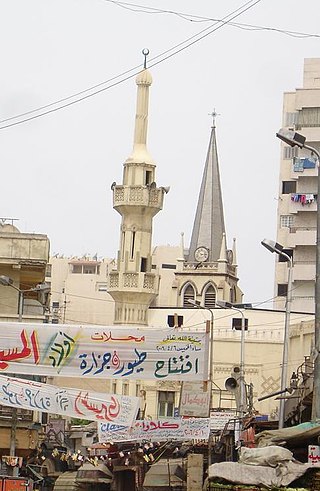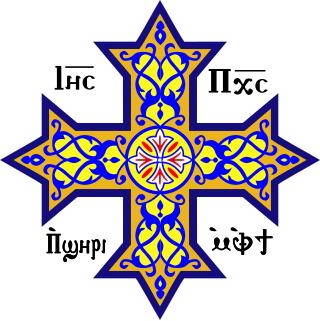Related Research Articles

The Coptic Orthodox Church, also known as the Coptic Orthodox Patriarchate of Alexandria, is an Oriental Orthodox Christian church based in Egypt. The head of the church and the See of Alexandria is the pope of Alexandria on the Holy Apostolic See of Saint Mark, who also carries the title of Father of fathers, Shepherd of shepherds, Ecumenical Judge and the 13th among the Apostles.
This timeline of Christian missions chronicles the global expansion of Christianity through a listing of the most significant missionary outreach events.

Copts are a Christian ethnoreligious group native to Northeast Africa who have primarily inhabited the area of modern Egypt and Sudan, and predominantly follow the Coptic Orthodox Church in Alexandria. They are the largest Christian denomination in Egypt and the Middle East, as well as in Sudan and Libya. Copts account for roughly 5–15 percent of the population of Egypt; while in Sudan they account for 1 percent of the population, and in Libya they similarly account for 1 percent of the population.
A Christian mission is an organized effort to carry on evangelism, in the name of the Christian faith. Missions involve sending individuals and groups across boundaries, most commonly geographical boundaries. Sometimes individuals are sent and are called missionaries, and historically may have been based in mission stations. When groups are sent, they are often called mission teams and they undertake mission trips. There are a few different kinds of mission trips: short-term, long-term, relational and those that simply help people in need. Some people choose to dedicate their whole lives to mission.
The purpose of this timeline is to give a detailed account of Christianity from the beginning of the current era (AD) to the present. Question marks ('?') on dates indicate approximate dates.
P'ent'ay is an originally Amharic–Tigrinya language term for Pentecostal Christians. Today, the term refers to all Evangelical Protestant denominations and organisations in Ethiopian and Eritrean societies. Alternative terms include Ethiopian–Eritrean Evangelicalism or the Ethiopian–Eritrean Evangelical Church. Sometimes the denominations and organizations are known as Wenigēlawī.

The United Presbyterian Church of North America (UPCNA) was an American Presbyterian denomination that existed for one hundred years. It was formed on May 26, 1858, by the union of the Northern branch of the Associate Reformed Presbyterian Church with the Associate Presbyterian Church (Seceders) at a convention at the Old City Hall in Pittsburgh. On May 28, 1958, it merged with the Presbyterian Church in the United States of America (PCUSA) at a conference in Pittsburgh to form the United Presbyterian Church in the United States of America (UPCUSA).

Religion in Egypt controls many aspects of social life and is endorsed by law. The state religion of Egypt is Islam, although estimates vary greatly in the absence of official statistics. Since the 2006 census, religion has been excluded, and thus available statistics are estimates made by religious and non-governmental agencies. The country is majority Sunni Muslim, with the next largest religious group being Coptic Orthodox Christians. The exact numbers are subject to controversy, with Christians alleging that they have been systemically under-counted in existing censuses.

The Evangelical Church of Egypt (Synod of the Nile) (also called the Evangelical Presbyterian Church in Egypt, Egyptian: الكنيسة الإنجيلية المشيخية El-Kenisa El-Engileyya El-Mashyykhia) is a Protestant church that started as a mission of the United Presbyterian Church of North America among Coptic Egyptians in the late nineteenth century. The Evangelical Church of Egypt became autonomous in 1957 and officially independent in 1958. It has eight presbyteries, 314 congregations, and about 250,000 members.

Christianity in Africa arrived in Africa in the 1st century AD, and in the 21st century the majority of Africans are Christians. Several African Christians influenced the early development of Christianity and shaped its doctrines, including Tertullian, Perpetua, Felicity, Clement of Alexandria, Origen of Alexandria, Cyprian, Athanasius and Augustine of Hippo. In the 4th century, the Aksumite empire in modern-day Ethiopia and Eritrea became one of the first regions in the world to adopt Christianity as its official religion, followed by the Nubian kingdoms of Nobatia, Makuria and Alodia and several Christian Berber kingdoms.

Christianity is the second largest religion in Egypt. The vast majority of Egyptian Christians are Copts. As of 2019, Copts in Egypt make up approximately 10 percent of the nation's population, with an estimated population of 9.5 million or 10 million. In 2018, approximately 90% of Egyptian Christians were Coptic Orthodox.

There are around 500,000 to 1,000,000 Protestants in Egypt, with 300,000 to 600,000 being members of the Evangelical Church of Egypt, Pentecostals number 300,000 to 350,000, and various other Protestants scattered in smaller denominations.
Characteristic of Christianity in the 19th century were evangelical revivals in some largely Protestant countries and later the effects of modern biblical scholarship on the churches. Liberal or modernist theology was one consequence of this. In Europe, the Roman Catholic Church strongly opposed liberalism and culture wars launched in Germany, Italy, Belgium and France. It strongly emphasized personal piety. In Europe there was a general move away from religious observance and belief in Christian teachings and a move towards secularism. In Protestantism, pietistic revivals were common.
Christianity in the 20th century was characterized by an accelerating secularization of Western society, which had begun in the 19th century, and by the spread of Christianity to non-Western regions of the world.
The Islamization of Egypt occurred after the seventh-century Muslim conquest, in which the Islamic Rashidun Caliphate seized control of Egypt from the Christian dominated Byzantine Empire. Egypt and other conquered territories in the Middle East gradually underwent a large-scale conversion from Christianity to Islam, motivated in part by a jizya tax for those who refused to convert. Islam became the faith of the majority of the population at some point between the 10th and 12th centuries, and Arabic became the main language, replacing Coptic and Greek, which had previously served as the vernacular and governmental languages, respectively.

Dr. Charles R. Watson was the first president of the American University in Cairo. His father was a member of the United Presbyterian Church Of North America African Mission. Watson grew up in Egypt and returned to the United States in 1889 to continue his education at Lawrenceville and then Princeton. He met his wife Maria Elizabeth Powell while attending Ohio State University. In 1912, Watson went on a mission with the United Presbyterian Board of Missions, with the primary goal of identifying the possibility of establishing a Christian university in Egypt. He returned from the mission with the strong belief that there should be another Western institution for higher learning in Egypt. The institution was finally launched in 1919 after enough funding and a suitable location could be guaranteed. He remained at the AUC until John Badeau succeeded him as president in 1945, although he was still heavily active in AUC activities until he died in 1948.
Rev. Dr. Andrea Zaki Stephanous is president of the Protestant Community of Egypt, and General Director of the Coptic Evangelical Organization for Social Services.

Heather J. Sharkey is an American historian of the Middle East and Africa, and of the modern Christian and Islamic worlds. Her books and articles have covered topics relating to nationalism, imperialism, colonialism, postcolonial studies, missionary movements, religious communities, and language politics, especially in Egypt and Sudan. She is currently Professor of Middle Eastern and Islamic Studies in the Department of Near Eastern Languages and Civilizations at the University of Pennsylvania in the United States.
Peter Heyling was a German Lutheran missionary to Egypt and Ethiopia. He was the first Protestant missionary to Ethiopia.
The Sunday School Movement is a catechetical movement within the Coptic Orthodox Church. It was founded in the early 20th century, in an effort to spread Oriental Orthodox theological education among the laity of the Coptic Orthodox Church, combating foreign missionary efforts orchestrated in 19th century Egypt by the Roman Catholic Church, the Church of England, and numerous American-protestant movements.
References
- ↑ Murphy, Lawrence R. (1987). The American University in Cairo: 1919–1987. The American University in Cairo Press. p. 2.
- ↑ B.L. Carter, "On Spreading the Gospel to Egyptians Sitting in Darkness: The Political Problems of Missionaries in Egypt in the 1930s," Middle Eastern Studies, Vol. 20, No. 4 (Oct., 1984), 18–36.
- ↑ Kenneth Scott Latourette, A History of the Expansion of Christianity (1944) 6:26; 7:258
- ↑ Heather J. Sharkey, "Empire and Muslim Conversion: Historical Reflections on Christian Missions in Egypt," Islam and Christian-Muslim Relations, Vol. 16, no. 1, 45–46.
- ↑ Heather J. Sharkey, American Evangelicals in Egypt, (2008), 159–167